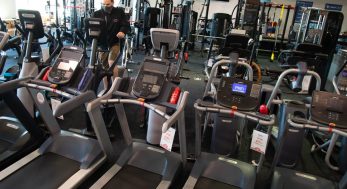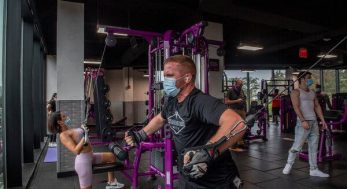Advertisement
Expect less crowds, but no group activities like spin classes or yoga.

Most New Yorkers have lived without communal workouts since mid-March, when Gov. Andrew M. Cuomo closed gyms in the state to prevent the spread of the coronavirus.
Gyms seem an intuitively high-risk environment, and New York waited months until it allowed the 2,000 or so gyms in the state to reopen. They were finally given the go-ahead on Aug. 24, along with museums, aquariums and bowling alleys.
The city waited until Wednesday to allow gyms to reopen, so that officials had more time to conduct inspections, which are taking place as the city also tries to reopen schools.
Gyms may be a sanctuary of sorts and a healthy outlet for stress when everyone in the city could use a release, but they remained closed as retail stores and restaurants reopened — at least for outdoor dining — and the rate of positive virus tests in the city continued to hover around 1 percent.
The reopening of gyms signals yet another step toward a return to normalcy, even though the pandemic is still a threat and many New Yorkers may not feel safe using them.
State officials said that they had tracked coronavirus infections connected to gyms in Hawaii and South Korea as case studies to inform their policies.
But while gyms are coming back, in the city and in most states, the scene at your local fitness center will be considerably different than it was before the start of the pandemic. Here is what to expect.
Free weights are available, but studios are not
Gyms offering weights and exercise machines are allowed to reopen, but many other exercise facilities in the city have not yet been given the go-ahead. Indoor pools and places that only offer group fitness classes, like spinning, Zumba, yoga and Pilates, are not allowed to reopen because the city sees those activities as higher risk.
One-on-one sessions with personal trainers or yoga teachers are allowed.
“We are certainly going to take a pretty strict stance in the name of preserving our low level of infection,” Mayor Bill de Blasio said on NY1’s “Inside City Hall” last week, adding, “We want to see jobs come back, we want to see amenities for people. We also have to make sure it’s done safely.”
Many fitness studio owners, who have started offering classes outside and teaching video sessions during the pandemic, believe the strict regulations that are keeping their businesses closed are unfair.
Amanda Freeman, who owns a dozen SLT studios in New York City and 14 outside of it, said that she thinks her low-impact workout routine is actually less dangerous than workouts at a conventional gym.
“We’re even more controlled, it’s by appointment only, there are very limited spots,” Ms. Freeman said. “I don’t understand why we’re worse than they are.”
Expect fewer lines for machines, and far more cleaning

Gyms may be open, but don’t expect capacity crowds. State regulations greatly limit the number of attendees, the distance between machines and many other factors.
Gyms may only fill up to 33 percent capacity. Gym-goers must wear face coverings, pass a health screening and maintain at least six feet of separation at all times. Equipment must be cleaned after each use, and signage detailing safe practices must be prominently displayed. Gyms need to install expensive filtration systems, if they do not already have them.
Different gyms are approaching the regulations in different ways. New York Sports Club and Equinox locations will operate under adjusted hours, and Equinox and Crunch gyms will use electrostatic disinfectant sprayers as an additional cleaning method.
These measures may not make for the most sociable workout, but they should help protect you from infection. State officials said that there was not a specific metric for whether gyms would need to close again, but that they would monitor the situation.
Many experts agree that even with the regulations, fitness centers could still be risky.
“Gyms can be high risk depending on the setup — from crowding, to close contact, a lack of masks, adequate ventilation, high-touch surfaces and a need for disinfection,” said Saskia Popescu, an epidemiologist at George Mason University. “The challenge is that people really need to be spaced out and wearing masks the entire time, and this includes the locker rooms.”
Health departments will inspect clubs
State regulations are to be enforced by local health departments, who are responsible for inspecting gyms within two weeks of their reopening. People from other agencies, like fire marshals or building inspectors, can also carry out inspections. Different health departments around the state work out the specifics of their inspections.
New York City’s inspections will be carried out virtually, with inspectors communicating with a gym owner on a video call to make certain that their precautions are up to code.
Gyms that do not meet the state requirements — say by not having a strong enough filtration system, insufficient personal protective equipment, signage or cleaning supplies — will have to close and will be fined up to $10,000 if they remain open without complying with state guidelines.
The future for fitness in the city is unclear
Reopening is sure to reinvigorate frustrated fitness fans, but the future for the workout industry in the city remains uncertain.
Reopening a gym can cost more than $20,000, especially with expensive upgrades to a location’s air filtration system. The added costs come after months without revenue, when many gym owners find themselves deep in debt, and will have to reopen to only a third of their normal customer base.
There is also the risk that people may be fearful of returning to fitness centers, or may have grown to prefer working out outside, or forgoing exercise altogether.
“Exercise is habitual, the longer you change a habit the harder it is to get back,” said Ms. Freeman, the studio owner.
Several gym owners said that they had heard a wide range of responses from their clients, but that many were enthusiastic to get back to their gyms.
One gym-goer, Mika Sneddon, said she had worked out a lot less with her personal trainer, Lunelle Belhomme, since gyms closed. She said she was eager to return to an atmosphere that inspired her to work out, and that she thought gyms as a whole would find a way to bounce back.
“Our ability to adapt is much greater than some people think,” Ms. Sneddon said. “I think it’s just a matter of accepting that maybe things might look different.”


